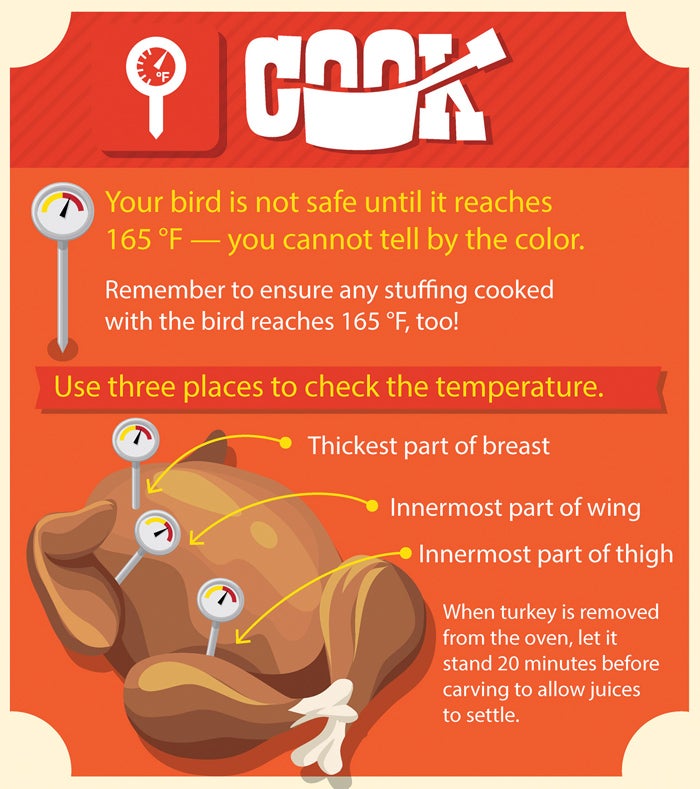Keep your food safe and everyone will be thankful
Published 12:00 am Friday, November 17, 2017
By Toi Degree
Rowan Cooperative Extension
Thanksgiving is quickly approaching and marks the official start of the holiday season. It is a time busy with large family gatherings, food and shopping that ends with the ringing in of the New Year.
While you are enjoying your parties, family dinners and other gatherings where food is served, make sure that you are practicing proper food safety. Since there are only four basic food safety measures that can help prevent foodborne illnesses, you won’t have a lot to remember.
Clean, separate, cook and chill are the four practices to keep in mind this holiday season.
Clean
The first rule of safe food preparation in the home is to keep everything clean.
- Wash hands with warm water and soap for 20 seconds before and after handling any food. For children, you can make it fun and tell them that they need to wash their hands the full time it takes to sing Happy Birthday twice.
- Wash food-contact surfaces — cutting boards, dishes, utensils, countertops with hot, soapy water after preparing each food item and before going on to the next item.
- Rinse fruits and vegetables thoroughly under cool running water, and you can also use a produce brush to remove surface dirt.
- Do not rinse raw meat and poultry before cooking. Washing these foods make it more likely for bacteria to spread to areas around the sink and countertops, thus spreading it throughout the kitchen.
Separate
Don’t give bacteria the opportunity to spread from one food to another (cross-contamination).
- Keep raw eggs, meat, poultry, seafood and their juices away from foods that aren’t going to be cooked. Take this precaution while shopping in the store, when storing in the refrigerator, while preparing meals and when using kitchen utensils for those products.
- Consider using one cutting board for foods that will be cooked such as raw meat, poultry and seafood, and another one for those that will not be cooked such as raw fruits and vegetables. The colored cutting boards make it easy for you to remember this: green for produce (fruits and vegetables) and yellow for uncooked poultry; red, raw meats; beige, fish; white, dairy; and blue for cooked foods.
- Do not put cooked meat or other food that is ready to eat on an unwashed plate that has held any raw eggs, meat, poultry, seafood or their juices.
Cook
Food is safely cooked when it reaches a high enough internal temperature to kill harmful bacteria.
- Color is not a reliable indicator of doneness. Use a food thermometer to make sure meat, poultry and fish are cooked to a safe internal temperature. To check a turkey for safety, insert a food thermometer into the innermost part of the thigh and wing and the thickest part of the breast. The turkey is safe when the temperature reaches 165 degrees. If the turkey is stuffed, the temperature of the stuffing should be 165 degrees.
- Bring sauces, soups and gravies to a rolling boil when reheating.
- Cook eggs until the yolk and white are firm. When making your own eggnog or other recipe calling for raw eggs, use pasteurized shell eggs, liquid or frozen pasteurized egg products, or powdered egg whites.
- Don’t eat uncooked cookie dough, which may contain raw eggs.
Chill
Refrigerate foods quickly because harmful bacteria grow rapidly at room temperature.
- Refrigerate leftovers and takeout foods and any type of food that should be refrigerated, within two hours. That includes pumpkin pie.
- Set your refrigerator at or below 40 degrees and the freezer at 0 degrees. Check both periodically with an appliance thermometer.
- Never defrost food at room temperature. Food can be defrosted safely in the refrigerator, under cold running water or in the microwave. Food thawed in cold water or in the microwave should be cooked immediately. Allow the correct amount of time to properly thaw food. For example, a 20-pound turkey needs four to five days to thaw completely when thawed in the refrigerator.
- Don’t taste food that looks or smells questionable. A good rule to follow is when in doubt, throw it out.
- Leftovers should be used within three to four days.
I wish you all a wonderful Thanksgiving with your family and friends. If you have any questions, feel free to give me a call. I have also listed a few websites that you may like to visit.
For more turkey basics, visit the USDA website at: http://www.fsis.usda.gov/Food_Safety_Education/usda_meat_&_poultry_hotline/index.asp or you may also call the USDA Meat & Poultry Hotline at: 1-888-674-6854.
Turkey Basics: Stuffing https://www.fsis.usda.gov/wps/portal/fsis/topics/food-safety-education/get-answers/food-safety-fact-sheets/poultry-preparation/turkey-basics-stuffing/CT_Index
Is it Done Yet? https://www.fsis.usda.gov/wps/wcm/connect/c825bac8-c024-4793-be76-159dfb56a88f/IsItDoneYet_Brochure.pdf?MOD=AJPERES
Toi N. Degree, Family and Consumer Education Agent, North Carolina Cooperative Extension Rowan County Center 704-216-8970 or e-mail toi_degree@ncsu.edu.





